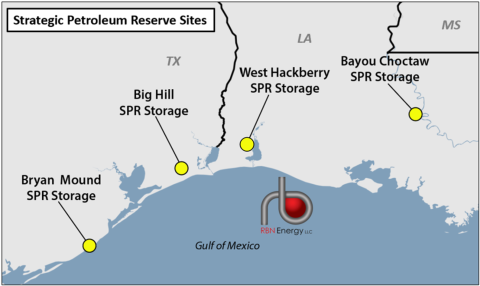Strategic Petroleum Reserve (SPR) inventories have been climbing over the past year as the Department of Energy (DOE) advances plans to replenish it following the record 180-MMbbl drawdown after Russia’s invasion of Ukraine in 2022. But DOE officials have said its refilling efforts are complicated by upgrades at three of the four SPR storage sites. In today’s RBN blog, we look at the scope of these “life-extension” projects, the completion timetable, and how it might drag out restocking efforts.
Before we dive in, let’s recap some key aspects of the SPR, the largest emergency crude stockpile in the world (see I Want To Break Free). As shown in Figure 1 below, the federal crude oil storage program is located at four sites: Bryan Mound and Big Hill in Texas and West Hackberry and Bayou Choctaw in Louisiana. Oil is kept in underground salt caverns — 61 in all — with a total authorized capacity of 714 MMbbl. The DOE maintains that the national crude oil reserve is always drawdown-ready, which means it can release barrels to the market within 13 days of presidential direction. (That is the time needed to conduct the sale/exchange process, award contracts, and arrange the logistics for oil transportation. The DOE estimates an additional 6-8 days of transit to ship barrels to PADD 1 and 16-18 days to ship barrels to PADD 5, with pipeline connections to the rest of PADD 3, PADD 2 and PADD 1.)
Figure 1. Strategic Petroleum Reserve Sites. Source: RBN
Following Russia’s invasion of Ukraine in February 2022 (red line in Figure 2 below), the Biden administration released 180 MMbbl of crude oil — or about 1 MMb/d over six months — to temper surges in crude and refined product prices. As we noted in Running Up That Hill, crude oil futures rallied to a 14-year high — West Texas Intermediate (WTI) crude oil zipped past $100/bbl shortly after the invasion and traded as high as $123.70/bbl — as supply uncertainty rattled markets and caused spikes in gasoline and diesel prices. President Biden also ordered the release to fill supply gaps until domestic output grew enough to fill them (see All I Need To Get By). The historic release began about three months after the war started and concluded in December 2022, adding to a drawdown already underway from government-mandated sales for bills passed in previous years. The SPR fell to its lowest level in 40 years — 346.8 MMbbl — in July 2023. (We should note that each SPR site can release barrels to the market much faster than it can add them. More on each of the four sites below.)
Join Backstage Pass to Read Full Article









